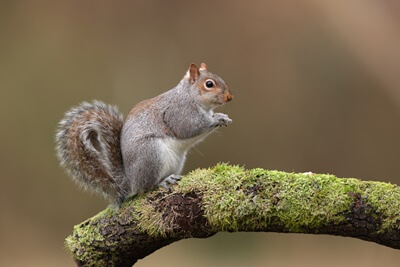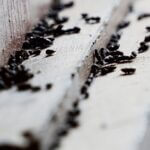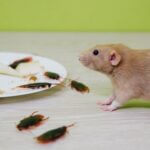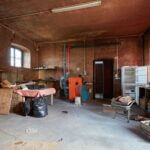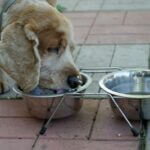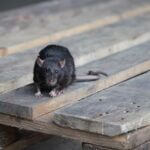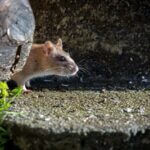Rat and squirrel droppings look similar and can be hard to differentiate. Squirrel droppings are lighter in color, smaller, and have rounded edges, while rat droppings are dark brown with tapered edges.
Squirrels will leave their poop in mounds, with approximately a dozen pellets in each spot. However, rats leave their poop everywhere as they travel through your home.
While fresh rat and squirrel poop are shiny, it’s normal for squirrel poop to lose its moisture sooner and become lighter-colored. Rat poop usually turns grey with age.
Difference Between Rat Poop And Squirrel Poop
Rat poop and squirrel poop can look similar, but there are some key differences:
Shape And Size
The shape of the droppings is the easiest way to determine whether you’re dealing with rats or squirrels. To check, look at the ends of each pellet.
Squirrel droppings are rounded at the edges and smaller than rat poop. Meanwhile, the edges of rat poop are pointed and taper at both ends. Also, rat poop is wider.
Color
Squirrels have poop that’s lighter in color than rat poop, usually a shade of brown or red. The poop tends to be paler in color than rat poop, likely because a squirrel’s diet is more limited than a rat’s.
In light of that, squirrels have a wider range of poop colors, including tan and green. The color of a squirrel’s poop will depend on its diet.
Rat poop can be darker in color, with dark brown or black pellets.
The more opportunistic the rat, the darker its poop color will be. Opportunistic rats tend to be less picky with their meals, eating from garbage and rotting food sources when available.
Texture
Both droppings will be shiny when fresh, but squirrel poop tends to dry out faster. When it does, it’ll lighten in color.
Rat droppings will take longer to dry, becoming brittle when they dry out. Eventually, old rat poop will turn grey.
Certain diseases can be released as the feces dry up and break apart.
Amount
Squirrels stay in one place for a long time, so expect squirrels to leave at least a dozen pellets in a pile.
Rats’ droppings will be strewn around because they’re always on the move and may poop as they run from one location to another.
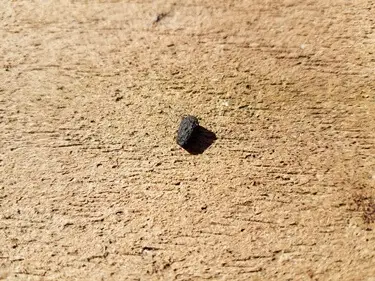
Where Do Squirrels Poop?
Squirrels usually poop in the same area. Also, remember that squirrels tend to hide in higher locations, unlike most rats.
You’ll often find squirrel poop in the following locations:
- Under bird feeders.
- Attics.
- Underneath trees.
Indoors
Because squirrels hide in high places, you’re more likely to find them on upper floors.
You’ll often find squirrels in attics, especially if it has an entrance to the outside. Open windows, especially those next to trees, are a common entrance for squirrels. You’ll often find squirrel poop near these exits.
Outdoors
Outdoors, you might want to check food sources that are perched high, like bird feeders and trees. You’ll find squirrel poop underneath these food sources.
Where Do Rats Poop?
Unlike squirrels, rats don’t like to be seen by humans. For this reason, they like staying in dark, hidden areas, which humans don’t frequent. Rats will also prefer areas that contain food sources.
When traveling, rats also prefer to stay hidden. They’ll stick to walls, fences, and underneath objects, taking the long route if it keeps them hidden.
Rat poop won’t appear in groups. Instead, it’ll be strewn about for two reasons.
Rats don’t like to stay in one place and may poop as they run. Also, rats use their poop to mark their territory. Their poop contains pheromones that tell other rats to stay away from the area.
For this reason, you’ll often find rat poop in the following areas.
- Behind storage spaces.
- Underneath kitchen counters.
- Alongside the walls of rooms like attics and garages.
- Near outdoor food sources, like garbage cans.
- Alongside fences.
What Does Squirrel Poop Smell Like?
Squirrel poop has a strong and pungent smell, primarily due to ammonia.
If ammonia comes into contact with the body, it reacts with water to produce ammonium hydroxide. This chemical is highly corrosive, making it uncomfortable to breathe in. However, it’s often hard to breathe in enough ammonium hydroxide for it to cause damage.
The smell of squirrel poop can make you sick, but this usually only happens when the poop has become so old that it has turned to dust and is then inhaled.
Squirrel Poop Vs. Rat Poop
Here is a quick breakdown of the differences between squirrel and rat poop:
| Squirrel Poop | Rat Poop | |
Shape: | Edges are rounded Like a coffee bean. | Edges are tapered. Bulging in the middle. Like a raisin. |
Size: | Length: 3/8 inch. Width: 1/8 inch. | Length: ¾ inch to ½ inch. Width: ¼ inch. |
Texture: | Shiny at first. Lightens in color when dry. | Remains shiny throughout. |
| Color: | Red, brown. | Dark brown. |
| Amount: | More numerous than rat droppings. Piles of no more than 12 pellets per pile. | Never in piles. Strewn about. |
| Location: | Same area. Higher areas. Rarely on floors or in corners. Outdoors and under food sources. | Indoors. No foot traffic. Dark, hidden areas. Areas near food sources. |
Is Rat And Squirrel Poop Dangerous?
All rodents pose a danger to human health. They can transmit disease through their bite, feces, and urine. The ticks, fleas, and mites they carry can also cause human diseases. Ecology and Epidemiology determined that rats carry 53 different infectious agents.
There are many reports of squirrels as disease vectors. The American Journal Of Tropical Medicine And Hygiene determined that western grey squirrels are hosts of Lyme disease. Likewise, Emerging Infectious Diseases details two cases of typhus fever transmitted by flying squirrels.
So, addressing your rat or squirrel problem as soon as possible is essential. The above tips will help you differentiate between them, allowing you to utilize the appropriate pest control method.

